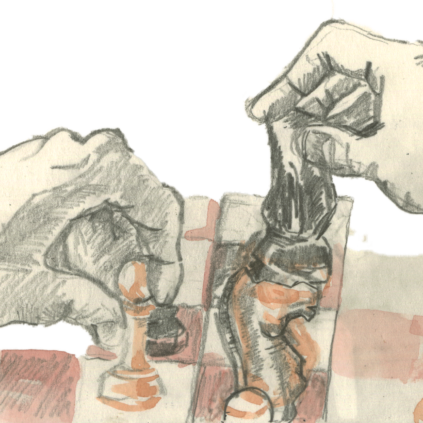Dear readers,
It started with a key and a health hazard.
They led us to the room. A busted couch, some metal drawers labeled Biz-Nass, filing pockets we’ve since swapped for Google Drive folders, a few ancient Mac desktops, someone named Jessica’s to-do list, a massive closet of archives dating back fifty-five years, and a wood-lacquered fridge filled with God-knows-what and God-knows-how-much black mold—signs of a former New Journal life. We burst inside, and began gathering scraps of editors’ past.
We could spend this whole letter telling you the otherwise underwhelming story of how The New Journal lost touch with its headquarters for a few years. Or we could tell you about the hours we spent clearing the room so it could be rid of its biohazard and reunited with us. But we’ll spare those details. Instead, like we think good journalists do, we’d like to focus on something more ambitious—the collision between this dusty office and the magazine you’re holding in your hands.
The New Journal exists with or without a room. For the past few years, it’s been spread out over Zoom screens, a lonely seminar room in Davenport College, some cluttered tables in Berkeley College’s Mendenhall room, and the apartment living rooms of this Managing Board, where we’ve pored over Google Docs and diction. A magazine doesn’t need a home to be made, maybe because it’s one of the most people-intensive things you can do, and a collection of people is in itself a kind of place.
But it sure is nice to have a place, despite all that. And what’s inside these pages demonstrates why. In Volume 55, Issue 1 of The New Journal, place is everywhere.
Two pieces look at the hidden costs of making Yale a place for students. Our cover story, by Abbey Kim, follows the graduate student workers whose experience of Yale as a workplace have long been invalidated by Yale’s failure to recognize their union, Local 33—but that may change soon. Saachi Grewal tunnels through the dark underbelly of Yale’s power plants, surfacing with the realization that the comforts of campus we don’t really think about—heating, electricity—have come at an indefensible cost to not only the planet, but also its power plants’ employees.
In the rest of the magazine, you’ll find other revisitations of forgotten places––made all the more real and immortal through the phenomenal visual imaginations of our designers and Creative Director, Kevin Chen. We wander backwards in time, into natural history museums, New Haven’s Institute Library, a Pac-Man machine, the Berkeley College Woodshop, a house surrendered to a wildfire—and with a personal essay, at the end of the magazine, we go home.
Putting out a magazine is like jumping off a cliff you’ve run a marathon to get to. As it should. Now it’s out of our hands, and in yours, where it belongs. These pages were made to be turned, folded, cut-up, spilled on and stowed away into your rooms’ shelves, corners, and crevices. They’re meant to be forgotten, then rediscovered, without having to locate a key or exterminator.
In his piece, Austin Todd urges us to hold on tightly, let go lightly. He put it well. We’re letting go, and we’re going home.
— The Managing Board


